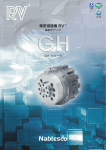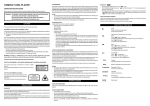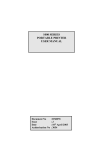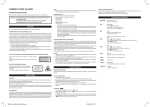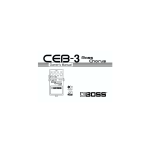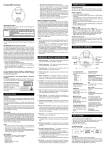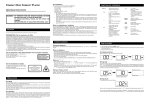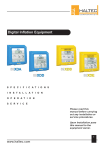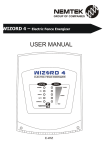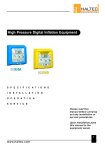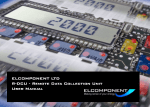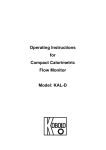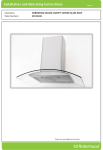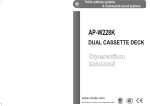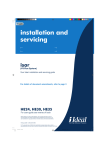Download Acorn Electron Data Recorder
Transcript
Location and function of controls ___________________________________________________________________________________ 1. 2. 3. 4. 5. 6. 7. 8. Motor Control Selector PAUSE Key STOP/EJECT Key FAST FORWARD/CUE Key REWIND/REVIEW Key PLAY Key RECORD Key Azimuth Adjustment (Please consult your dealer) 9. 10. 11. 12. 13. 14. 15. 16. DC INPUT SOCKET DIN Socket RECORD Indicator (Yellow) DATA Indicator (Green) POWER Indicator (Red) Tape Counter Cassette compartment Battery compartment Precautions ___________________________________________________________________________________ The mains adaptor WARNING: Under no circumstances should the mains adaptor be replaced by a normal mains plug. The mains adaptor contains components to convert the mains to a safe, low voltage (dc), for input to the Data Recorder. There is a thermal fuse build into the mains adaptor and if this blows, you must replace the adaptor. Please consult your local dealer. The mains adaptor should not be left plugged into the domestic 13A socket for long periods if the Data Recorder is not being used. Do not expose the mains adaptor to rain or moisture. Do not leave the PLAY key depressed for long periods when not in use, as this may damage the mechanism. Other Precautions When the recorder is not to be used for long periods of time or when operated extensively with the mains adaptor, remove the batteries to avoid damage from battery leakage. Do not install the recorder in a location near hear sources such as radiation or airducts, or in a place subject to direct sunlight, excessive dust, mechanical vibration, or shock. Power Supply A. Mains operation Plug the adaptor lead into the Data Recorder adaptor socket (marked: 6V. D.C. POWER IN) [9]. Insertion of this plug automatically disconnects the internal batteries. Plug the mains adaptor into a domestic 13A socket and switch on at the socket. The power indicator [13] will illuminate as an indication that the adaptor is in use. The ALF03 will now operate using the mains when a mains socket is within reach. WARNING: Disconnect from the mains when not in use. B. Battery Operation Place the recorder face down on a flat surface, and remove the battery-cover. Insert 4 HP11 batteries (or equivalent), carefully observing correct polarity as indicated on the batteries and in the battery compartment [16]. Replace the battery cover. The power indicator should not be illuminated during battery operation. Interference between data recorder and microcomputer Connect the 7 pin DIN lead from the DIN socket [10] of the Data Recorder to the Cassette Socket of the Microcomputer. Cassette insertion Before inserting a cassette, check the tape tension and make sure that any slack is taken up. This can be done by inserting a pencil into one of the hub holes and turning to take up the slack. This simple operation will prevent tape-spill and loop-throwing both of which can physically damage the tape and spoil recordings. – Press the Stop/Eject Key (3) to open cassette holder. – Place the cassette in the holder, insert the cassette with the desired side, A or B, uppermost. – Close the recorder by pressing down firmly to ensure cassette is correctly located. – To take out the cassette, press the Stop/Eject Key (3). NOTE: C15, C30, C60 data cassettes should be used only. (The use of C90 and C120 cassettes is not recommended with this data recorder). Do not attempt to load a cassette when the mechanism is engaged. Do not attempt to remove a cassette without first disengaging any function by using the Stop/Eject Key [3]. Motor control The motor control selector [1] is used to switch motor control between the remote computer and local recorder control. Computer Control: Motor Start/Stop is controlled by the Computer via the 7 pin DIN lead, (an appropriate key switch must also be selected, i.e. Play, Fast-Forward or Rewind). Manual Control: Motor Start/Stop is controlled directly by the Recorder with or without the 7 pin DIN plug in place. The recorder should be in computer control mode during saving or loading of data/programs. Saving programs from an Acorn Electron or BBC Microcomputer Insert a cassette and refer to the Microcomputer System User Guide, Recording Programs on cassette (Electron page 7 and BBC page 34). Press the Record Key [7] and Play Key [6] simultaneously until locked. The record indicator [11] will light up. The recorder is now enabled for recording data under computer motor control as described in the Microcomputer User Guide. During recording the recording level is automatically adjusted for optimum results by the Automatic Level Control (ALC) circuitry. The Data indicator [12] will light up when blocks of data are being recorded. If the end of tape is reached during recording, your recorder will shut off automatically. The Record Key and Play Key will also be released from their locked positions. Note: If the end of tape is reached before the program has been completely saved then you must save the whole program on a different part of the tape or the program will be lost. When the computer has finished saving the program on the tape, the motor will automatically stop. If further recording is not required the Stop/Eject Key on the recorder should be depressed to unload the head mechanism. Loading programs into a computer from the data recorder Refer to the Microcomputer System User Guide, Loading programs from cassette. Insert a recorded cassette into the Cassette Compartment [15]. Press the Play Key [6] until it locks. The recorder is now enabled for playback under computer control. The Data indicator [12] will light up when blocks of data are being played back. When the tape reaches its end, the tape drive mechanism is released and the power is turned off automatically. The Play Key is also released from its locked position. The signal output level from the recorder has been optimised for best results with the Acorn Electron and BBC Microcomputer. Cue (F.Fwd) and review (rewind) Manual Control: The tape can be rapidly advanced or rewound by depressing and latching the FF/cue key [4] or rewind/review key [5] as appropriate. To stop the tape press stop [3]. If the recorder is in the 'Play' mode (i.e. the PLAY key [6] is depressed), the Cue and Review keys will not latch on depression but will cause the tape to rapidly advance or rewind whilst the relevant key is depressed. The recorder reverts back to the 'play' mode when the Cue/Rewind key is released. Computer Control: If the cassette motor has been activated by the computer as described in the microcomputer user guide (e.g. by using the *CAT command), the cue and review features operate as described above under manual control. Use of tape counter When recording from the beginning of a tape, set the Tape Counter [14] to the '000' position by pressing the Counter Reset Button. The tape counter shows the positions of sections recorded on the tape while it is being played so that you may locate those sections again during playback. Storing the cassette – Replace the cassette in its protective holder immediately after use to protect it from dust and to prevent the tape from being unwound in the cassette. Store in a cool, dry place away from direct sunlight and strong magnetic fields such as speakers and electric motors. Caution – When the tape reaches its end during fast forward or rewind operation it stops automatically but the motor remains running. Be sure to stop the motor by pressing the Stop Key [3] or otherwise the tape drive mechanism may be damaged. – Keep the machine and cassettes away from strong magnetic fields, such as close to large transformers, electric motors, television receivers and loudspeakers. – Do not make excessive use of the Fast Forward and Rewind buttons in searching for a particular item on a cassette; this may cause "stepping" or ridges in the layers of tape and thus cause jamming, triggering the autostop. – Do not touch recording head with screw-driver or other metallic or magnetic objects. Maintenance of the cassette mechanism – The parts of the machine coming into direct contact with the tape do require periodic cleaning to ensure continuing good performance. – The tape heads (erase head, record/play head) should be cleaned using a cotton bud moistened with a drop of isopropyl alcohol solution or proprietary tape head cleaner or, alternatively, by a good quality Tape Head Cleaning cassette. – The pinch-roller and capstan shaft may be cleaned in a similar manner. – To gain better access to these parts of the mechanism, remove any cassette from the compartment and leave the compartment door open. Pressing the Play Key [6] will engage the mechanism and move all parts into view. – It will be found easier to clean the pinch-roller if the power source is connected (batteries or mains) so that the roller and the capstan shaft rotate. – Failure to maintain the tape heads in a clean condition will result in program errors and incomplete erasure. – Failure to maintain the pinch-roller and capstan shaft in a clean condition is likely to cause the tape to entangle and spill out of the cassette. Demagnetizing the head Either prolonged use or an accidental contact with a piece of magnetized steel (screwdriver, scissors, etc) will magnetize the Record/Playback Head causing an increase in tape noise. In such an event, demagnetize the head using a commercially available head demagnetizer. – – Be careful not to demagnetize the Erase Head. When demagnetizing, remove the batteries and disconnect the AC power cord. Cleaning the cabinet – Clean the cabinet with a soft cloth slightly moistened with water or a mild detergent solution. Do not use solvents such as alcohol, benzine or thinners as they may damage the finish of the cabinet. Protection Against Accidental Erasure – Normally, anything recorded on the tape is automatically erased when a new recording is made. – It is possible to protect your recordings from accidental erasure by removing the erase-lock tabs found on the rear of the cassette. – When the cassette is held with the recorded side uppermost, the protective tab will be found on the left of the rear edge of the cassette. – All pre-recorded cassettes are protected in this way to prevent accidental erasure of the commercial recording. – "Protected" cassettes may be re-recorded simply by fixing a piece of adhesive tape over the hole where the tab has been removed. This takes place of the tab and your machine can now be engaged in the record mode. A "protected" cassette will prevent the record button from being depressed. If at any time you attempt to record, and this button will not engage, never force the mechanism or damage will result. Check that a cassette has been loaded properly and that the erase-lock tab has not been removed. Preparing the unit for normal audio use For use as a monaural cassette unit, i.e. for normal record and playback of music or speech, it will be necessary to make up a separate connecting lead to that used with the computer. The connections required at the cassette end of the lead should be made as indicated in the drawing below:A. When the input is from a stereo source connect as follows:- B. When the input is from a monoural source:– Connect input lead to either pins 1 or 4. – Connect output lead to either pins 3 or 5. – Connect common lead to pin 2. A standard 5 pin 180 degree DIN Plug may be plugged into the 7 pin DIN socket on the Data Recorder. The motor control selector [1] must be in the 'MANUAL' position for operation in this mode. Product specification ___________________________________________________________________________________ 1. EQUIPMENT: Data Recorder 2. ORDER CODE: ALF03 3. FUNCTION: Program and data storage on C15 up to C60 cassette tape 4. DESCRIPTION OF OPERATION: Mono data recorder with switchable motor control facility 5. CAPACITY: Approx 30 Kbytes/side on C15 Approx 120 Kbytes/side on C60 6. FORMAT: 300 or 1200 baud computer user tape standard 1200 and 2400HZ tones. 7. SPEED: 4.7 cm/second - 2% to +3% Fast forward and rewind in 100 seconds for C60 8. CONTROLS: 6 key mechanism for "pause", "play", "stop and eject", "cue/fast forward", "review/rewind" and "record". 9. COMPUTER/MANUAL CONTROL. The motor can be controlled from a remote computer if this facility exists. 10. INDICATORS: Power, data and Record indicators. Tape counter with reset button. 11. SIGNAL CONNECTIONS: 7 pin DIN for input/output/motor control Input signal range 5mV to 500mV Input impedance 40k Ohm Output signal 500mV RMS at φdb tape level. 12. POWER IN: 4 x HP11 1.5 volt cells or ALF03 mains adaptor 13. APPROVALS: To conform to BS415:79 14. OPERATING TEMPERATURE: 0 degree C to 35 degree C. 15. ACCESSORIES INCLUDED: ALF03 mains adaptor; 7 pin DIN to 7 pin DIN lead and this User Manual. This apparatus has been produced to comply with Directive No 76/889/EEC (CISPR14)









